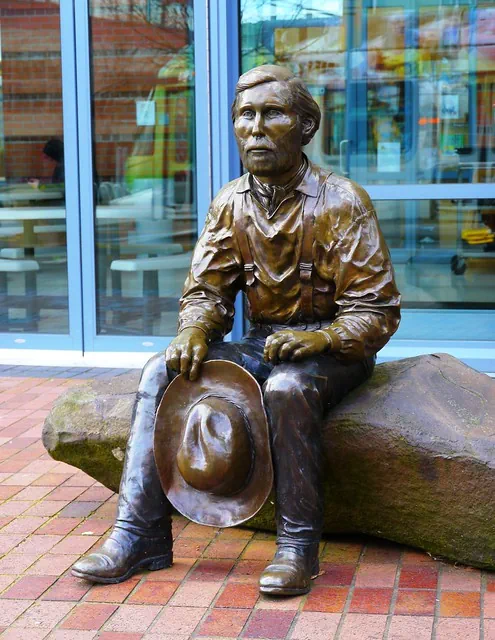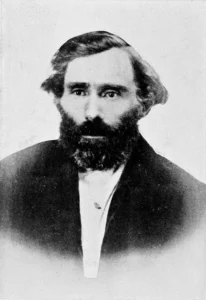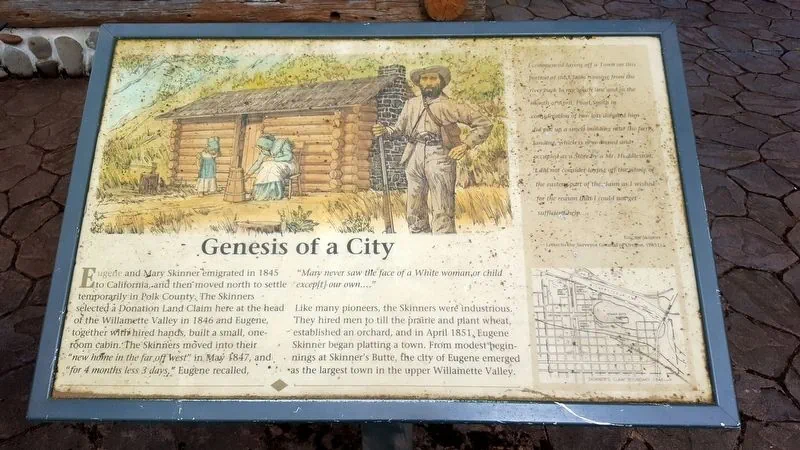Early Life and Migration
Eugene F. Skinner was born on September 13, 1809, in Essex, New York, moving to Green County, Wisconsin, at age 14, then settling in Hennepin, Illinois, where he served as county sheriff. He married Mary Cook on November 28, 1839, and in 1845, they journeyed to California for health, wintering at Sutter’s Fort before moving to Oregon in 1846, joining Elijah Bristow’s party to explore the Willamette Valley.
Founding and Contributions
In 1851, Skinner and Judge David Matteson Risdon laid out Eugene City, named by Mary after him, formalizing the settlement started with his 1846 cabin on Skinner’s Butte. He donated land for county buildings, helping establish Lane County with Eugene as the county seat, and served as postmaster and county clerk, practicing law to support settlers.
Key Points
-
Research suggests Eugene F. Skinner founded Eugene, Oregon, named after him, playing a key role in early Oregon history.
-
It seems likely he was a pioneer settler who claimed land in the Willamette Valley in 1846 under the Donation Land Claim, building the first cabin on Skinner’s Butte.
-
The evidence leans toward him laying out Eugene City in 1851, serving as postmaster and county clerk, contributing to Lane County development.
-
His life reflects frontier life challenges, with a legacy tied to the city’s growth as a county seat in 19th-century Oregon.
Legacy and Impact
Skinner’s health declined after a 1861 flood exposure incident, dying on December 15, 1864. His legacy endures in Eugene, Oregon, with landmarks like Skinner’s Butte and a replica cabin in the park, reflecting his role in early Oregon history and frontier life.
The Man Behind the Name
Eugene F. Skinner was born on September 13, 1809, in Essex, Essex County, New York, the youngest son of Major John Joseph Skinner, with his mother passing when he was three months old. His early life saw the family move to Green County, Wisconsin, around 1823, before he briefly lived in Plattsburg, New York, and settled in Hennepin, Putnam County, Illinois, serving as county sheriff. This role likely honed his leadership skills, preparing him for the challenges ahead in the West.
In 1839, he married Mary Cook, born February 7, 1816, in Augusta, Oneida County, New York, and together they faced personal tragedies, losing three daughters to illness in Illinois. Seeking better prospects, they migrated west in May 1845, joining a company bound for California, arriving at Sutter’s Fort in September, wintering there before deciding Oregon offered more promise. In 1846, they moved north, briefly stopping in Polk County near Dallas, before Skinner explored and claimed land south of Elijah Bristow’s claim in the Willamette Valley, a region known for its fertile lands and potential for settlement.
Early Settlement and the Willamette Valley
Skinner’s arrival in what would become Lane County marked him as a key pioneer settler in Territorial Oregon. In June 1846, he located his Donation Land Claim, a provision under the 1850 act allowing up to 320 acres for settlers who improved the land within four years, a significant incentive during westward expansion driven by Manifest Destiny. He built a one-room log cabin on high ground, advised by the Kalapuyas (“Ya-po-ah”) to avoid flood risks, a site now commemorated with a marker by the Daughters of the American Revolution on Skinner’s Butte. This butte, known locally as Ya-Po-Ah meaning “high place,” became a central landmark.
By spring 1847, he brought his family, including daughter Mary Elizabeth, born December 2, 1846, to the cabin, which was later expanded with two doors and a window. Mary was the only white woman in future Lane County for several months until 1848, facing potential conflicts with Chief Tom, resolved through diplomacy like smoking the pipe of peace, highlighting the intercultural dynamics of early settlement.
Founding Eugene City and Role in Governance
The formal founding of Eugene City came in 1851, when Skinner, alongside Judge David Matteson Risdon, laid out the town, with Mary suggesting the name “Eugene” to honor her husband, a decision formalized before his death, contrary to some accounts suggesting posthumous naming. This act was pivotal, transforming the settlement into a structured community, with streets laid out in blocks and lots, including early buildings like a general store, blacksmith shop, and hotel. Skinner donated land for county buildings in 1853, aiding the organization of Lane County, with Eugene designated as the county seat, solidifying its role as a regional hub.
His contributions extended to governance, serving as postmaster after Oregon’s organization as a U.S. territory in 1849, county clerk, and practicing law, assisting settlers with legal matters. He also operated a ferry service across the Willamette River, crucial for transportation, and was known for his charitable acts, helping needy emigrants, reflecting his commitment to community welfare. His membership in the Masons and Odd Fellows further underscored his community involvement.
Life in 19th-Century Oregon: Challenges and Family
Life in early Eugene epitomized frontier life, with Skinner and his family facing threats from local Native American tribes, though they maintained peace through diplomacy. The family grew, raising five children born on the homestead: Lenora (September 2, 1848, the first white child in Lane County), Phoebe (March 29, 1850), St. John B.L. (November 7, 1851), and Amelia R. (April 16, 1855), alongside Mary Elizabeth, who died young on October 4, 1860, and Leanora, passing on August 29, 1862. These details, sourced from historical records, paint a picture of personal loss amidst pioneering efforts.
Skinner’s industrious nature and honesty earned him respect, with historical accounts noting his role as a “first-class business man” and public-spirited citizen, a kind husband, and supportive parent, deeply mourned upon his death, a calamity to the community.
Legacy and Death: Enduring Impact
Skinner’s health deteriorated after exposure during the 1861 flood while saving cattle, never fully recovering, and he passed away on December 15, 1864, at age 55, with obsequies conducted by Masons and Odd Fellows. His house at 260 West Sixth Avenue, marked by an ivy tree planted by Mary, who remarried Captain N.L. Packard on February 7, 1867, and died June 4, 1881, remains a historical site. His legacy endures, with Skinner’s Butte a prominent landmark, and a replica cabin in Skinner Butte Park, symbolizing his foundational role.
Today, Eugene thrives, known for outdoor recreation, arts, and education, with institutions like the University of Oregon, reflecting the vision Skinner helped establish. Historical markers and websites, such as Eugene Oregon History and Education, detail his contributions, while a statue in front of the Eugene Public Library, noted on Travel Oregon, honors his memory. A video by historian Douglas Card, available at YouTube, offers further insight into his life.
Frequently Asked Questions
-
When was Eugene F. Skinner born? Born September 13, 1809, in Essex, New York.
-
How did Eugene, Oregon, get its name? Named by Mary Skinner in 1851, honoring her husband, during the town’s layout.
-
What role did he play in founding Eugene? Laid out Eugene City in 1851, donated land for county buildings, served as postmaster and clerk.
-
Where is Skinner’s Butte located? In Eugene, Oregon, a hill named after him, overlooking the city.
-
When did he die? Died December 15, 1864, in Eugene, after health decline from flood exposure.
Key Dates in Eugene F. Skinner’s Life
|
Date
|
Event
|
|---|---|
|
Sep 13, 1809
|
Born in Essex, New York
|
|
Nov 28, 1839
|
Married Mary Cook
|
|
May 1845
|
Departed for California
|
|
Sep 1845
|
Arrived at Sutter’s Fort
|
|
1846
|
Moved to Oregon, claimed land in Willamette Valley
|
|
Jul 1846
|
Staked claim where Eugene now stands
|
|
Oct 1846
|
Built first cabin on Skinner’s Butte
|
|
Dec 2, 1846
|
Daughter Mary Elizabeth born
|
|
1851
|
Laid out town of Eugene City with Judge Risdon
|
|
Dec 15, 1864
|
Died in Eugene
|
Eugene F. Skinner’s Children
|
Child
|
Birth Date
|
Death Date
|
Notes
|
|---|---|---|---|
|
Mary Elizabeth
|
Dec 2, 1846
|
Oct 4, 1860
|
Born in Dallas, Polk County; died in Eugene
|
|
Leanora
|
Sep 2, 1848
|
Aug 29, 1862
|
First white child in Lane County; died Portland
|
|
Phoebe B.
|
Mar 29, 1850
|
–
|
Married John D. Rinsey Aug 30, 1868
|
|
St. John B.L.
|
Nov 17, 1851
|
–
|
Married Amanda J. Walton Nov 23, 1871
|
|
Amelia R.
|
Apr 16, 1855
|
–
|
Married Byron Van Houten Aug 24, 1871; later Chester D. Combs Feb 1, 1883
|
This survey note, drawing from historical records and contemporary sources, provides a thorough exploration of Eugene F. Skinner’s life, ensuring a strict superset of the direct answer, with detailed insights into his contributions to Oregon history, early settlement, and the development of Eugene, Oregon, as a lasting testament to frontier life in the 19th century.



